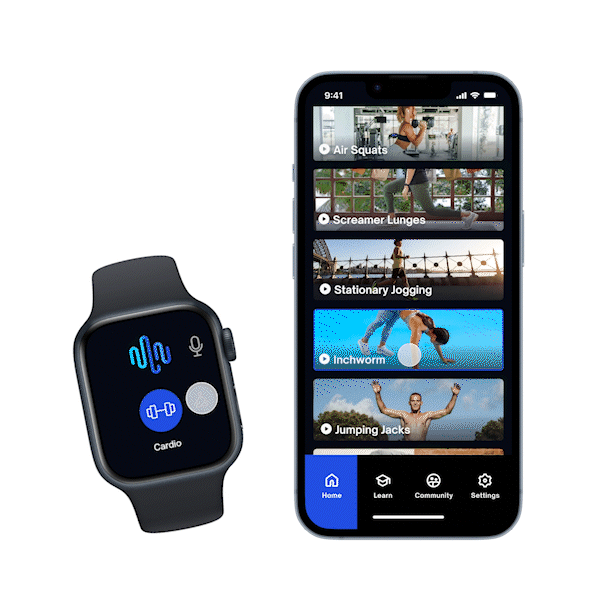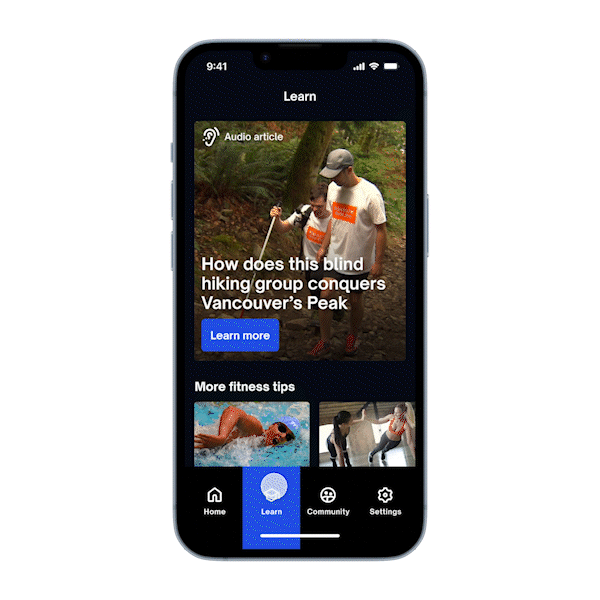
MOBILE APP + SMARTWATCH
ToneVision
PROJECT SUMMARY
Iterate UX design challenge aimed at addressing the physical and emotional pains of people with a visual impairment disability via an audio workout app and smartwatch component
DURATION
Feb - Mar 2023 (4 weeks)
Ongoing
TEAM
CONTRIBUTIONS
Concept Ideation
User Research
Competitive Research
UI Design
Interaction Design
Prototyping
TOOLS
Figma, Figjam, Whimsical, Zoom, Miro, Google Forms
Jwalitha Akurathi
Yoonjung Chui
Alex Weaver

Visually-impaired people struggle with more than just their disability
According to the Center for Disease Control and Prevention (CDC), over 12 million Americans over 40 have a visual impairment, including 1 million who are blind.
Members of this community are less likely to be physically active and are at a greater risk than others of developing chronic ailments like diabetes and heart disease.
There’s an emotional component to their burden and barriers, from a lack of motivation, fear of ridicule and embarrassment, to anxiety, and depression. In addition, they experience problems accessing healthcare and medical insurance as well as affording a physical trainer.
How might we?
...make fitness programs accessible for people with visual impairments so they can take ownership of their physical and emotional wellbeing?

SOLUTION
Toning both body and mind
ToneVision provides visually impaired adults with an opportunity to safely exercise and move their bodies, whether they're outdoors taking a walk, or dancing in the comfort of their own home.
More than a vehicle to perform workouts, my team and I conceived this as a wellness app with a bigger purpose: to build community, and inspire a positive change for those who have been kept in the dark.
KEY SOLUTIONS
Guided audio workouts
Users can either select to do a "Cardio" exercise, train in "Yoga" or perform breath work with a "Meditation." After each recording is complete, they are encouraged to reflect on their experience, try the same exercise again or move on to the next one.
The exercise selection, time tracking, and playing experience will also be synced with ToneVision's smartwatch app.


Learning how to stay fit

A path towards motivation
ToneVision's "Learn" section features insightful audio articles, helpful tips for any stage of the user's fitness journey, and healthy food recipes.
The "Community" section introduces inspirational stories and podcasts, as well as an audio-enabled chat where users can connect and support each other.
USER RESEARCH
Blind people are aware of their limitations but are determined to be self-sufficient
In the initial stage of this design challenge, my team and I were motivated to address visual impairment disabilities after an extensive review of internet articles that spoke to the vulnerability of this group, as well as first-hand access to people that experience this disability in our communities.
A survey was conducted with nine North American respondents between the ages of 18 and 57, recruited from our personal networks, a Slack community for web accessibility discussions, and Facebook groups for people with disabilities on a fitness journey.
Their insights confirmed a noticeable lack of physical engagement in their day-to-day:
55.6% only exercise twice or three times a week
100% want to improve their physical and mental health
100% struggle to find the motivation to workout
55.6% enjoy working out in the comfort of their home or outdoors
44.4% feel very confident about exercising on their own
44.4% hardly discuss physical well-being with a healthcare professional
To further my understanding, I interviewed four individuals ages 24-50 who either identify as a person with a visual impairment or a caregiver of someone who is expressing interest in improving their fitness level.
Here's what they told me:
Working out depends on the location and climate. I do want to feel fit but I struggle to gather the motivation for it
HANA
New York, NY
I tried to find a fitness app for my client but I wasn't successful. There aren't a lot, and some of them are expensive!
RAFAEL
San Francisco, CA
I should be able to walk by myself on the walking tracks, and access gym equiptment independently
SUMAR
India
Sometimes it's hard to walk into a space that's lonely or go through heavy transit and construction
CARLOS
San Francisco, CA
Given the insights I gathered during my user interviews, we envisioned an ideal user who, despite his blindness and challenges, wants to take a better care of himself.
MEET THE USER

Rob
I don't see myself as someone who is "blind". I just have a different characteristic than most people. It’s not a disability to me.
Although he leads a sedentary life, Rob wants to be more active. He has learned to use many accessible features and apps that help him in his everyday tasks.
FRUSTRATIONS
Lack of accessible equipment and gym space. Gets easily overwhelmed trying to keep up with workouts. Has no friends who want to get active.
COMPARATIVE ANALYSIS
Not enough support and assistance for visually-impaired users' fitness journey
For our competitive analysis, I looked at three major applications and their functionalities: the Google-owned Fitbit, audio fitness app Aaptive, and Revision, created by personal trainer and 4-time Paralympic athlete Tyler Merren.
While they do possess a variety of accessibility features, navigation cues, and audio descriptions that complement the working-out experience (proper technique and form, different ways to move the body, equipment setup, etc.), users are bound to encounter serious limitations.

For example, users of the Aaptiv app will have to pay a hefty subscription price for features like interacting with a personal trainer and connecting with fellow users.
Although Revision is built with the visually impaired athlete in mind, so far it hasn't enabled integration with wearable devices such as the Apple Watch. It also lacks social features, workout customization, and ways for the user to track their exercise progress.
NEXT STEPS
Taking a cue from the wizard
Because of the structure of the Iterate UX design challenge, my team and I were unable to follow through the much-needed testing and iteration stages during our 4-week working period.
However, I feel it’s vital to test what we created with people experiencing different types of visual impairments, and that comes with a carefully-made plan, taking into consideration WCAG standards and the limitations of screen reading software like VoiceOver and JAWS interacting with Figma prototypes.

Suggestions drawn by members of Slack accessibility discussion channel A11y pointed to the direction of the "Wizard of Oz" or "WOZ" method, which involves interaction with a mock interface controlled by members of the research team.
This is a great and cost-effective opportunity to learn more about our target users' specific needs, and points for improvement that can be included in future iterations.
REFLECTIONS
Our team's score during the challenge were among the top 5 highest of all the groups that participated. Both organizers and judging panel applauded our visual and clear presentation.
The importance of team work: Two of our original teammates left the project at pivotal stages, and it came down to the organization and dedication of our remaining members to fulfill expectations, and submit our work in a timely manner.
More preparation of research methodologies: Due to time constraints, we dealt with difficulties in accruing more data from our user base. This is a great reminder that every project requires good preparation to tackle research methodologies that can help achieve our goals.
Focus on inclusivity: None of us can attest to the experience of living with a visual impairment. We believe that inclusivity is felt and implemented not only through designing for all but having folks from underrepresented communities like people with visual impairment chime in on their journey, and provide insights that will benefit those living with that disability.


